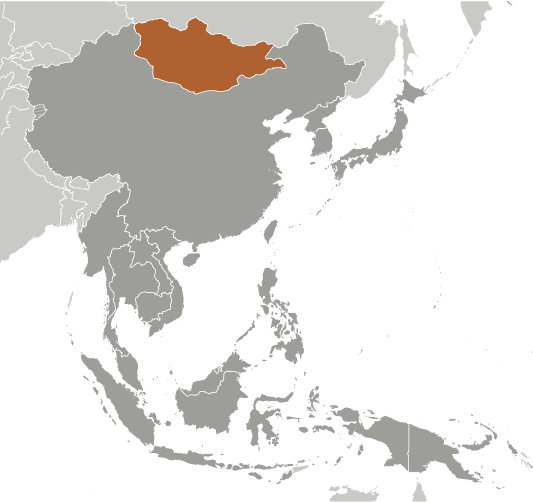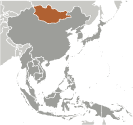
|
|
Advertisements:
EconomyEconomy - overview
Economic activity in Mongolia was traditionally based on herding and agriculture - Mongolia's extensive mineral deposits, however, have attracted foreign investors, and the country is undergoing an economic transformation through its mining boom. Mongolia holds copper, gold, coal, molybdenum, fluorspar, uranium, tin, and tungsten deposits, among others, which account for a large part of foreign direct investment and government revenues. Soviet assistance, at its height one-third of GDP, disappeared almost overnight in 1990 and 1991 at the time of the dismantlement of the USSR. The following decade saw Mongolia endure both deep recession, because of political inaction and natural disasters, as well as economic growth, because of reform-embracing, free-market economics and extensive privatization of the formerly state-run economy. The country opened a fledgling stock exchange in 1991. Mongolia joined the World Trade Organization in 1997 and seeks to expand its participation in regional economic and trade regimes. Growth averaged nearly 9% per year in 2004-08 largely because of high copper prices and new gold production. By late 2008, the country was faced with external shocks from the global financial crisis, and a sharp drop in commodity prices slashed government revenues. GDP dropped 1.3% in 2009. In early 2009, the International Monetary Fund reached a $236 million Stand-by Arrangement with Mongolia and the country has largely emerged from the crisis. The banking sector is recovering and the government has started to enact greater supervision regulations. In October 2009, Mongolia passed long-awaited legislation on an investment agreement to develop the Oyu Tolgoi mine, considered to be among the world's largest untapped copper deposits. Another similarly lengthy process is underway for an investment agreement for the massive coal mine at Tavan Tolgoi; it is under review by the National Security Council and a final decision is expected in 2012. The economy grew 6.4% in 2010 and 17.3% in 2011, largely on the strength of commodity exports to nearby countries. Trade with China represents more than half of Mongolia's total external trade - China receives more than 90% of Mongolia's exports. Mongolia purchases 95% of its petroleum products and a substantial amount of electric power from Russia, leaving it vulnerable to price increases. In the face of anticipated growth in mining revenues, the country is grappling with the challenge of avoiding an overheated economy. Due to severe winter weather in 2009-10, Mongolia lost 22% of its total livestock, and meat prices doubled. Renewed concerns are surfacing over controlling inflation, which was more than 10% for much of 2010-11, due in part to soaring food prices. Government spending - on line to increase as much as 75% over 2011 - has added to concerns over inflation. Remittances from Mongolians working abroad, particularly in South Korea, are significant. Money-laundering is a growing concern. Gdp (purchasing power parity) World Ranking: 142
$13.43 billion (2011 est.)
$11.46 billion (2010 est.) $10.77 billion (2009 est.) Note Data are in 2011 US dollars Gdp (official exchange rate)
$8.506 billion (2011 est.)
Gdp - real growth rate World Ranking: 2
17.3% (2011 est.)
6.4% (2010 est.) -1.3% (2009 est.) Gdp - per capita (ppp) World Ranking: 155
$4,800 (2011 est.)
$4,200 (2010 est.) $4,000 (2009 est.) Note Data are in 2011 US dollars Gdp - composition by sector
Agriculture 15.8%
Industry 32.6% Services 51.6% (2011 est.) Labor force World Ranking: 141
1.147 million (2010 est.)
Labor force - by occupation
Agriculture 33.5%
Industry 11.5% Services 55% (2010) Unemployment rate World Ranking: 110
9.9% (2010)
11.5% (2009) Population below poverty line
39.2% (2010)
Household income or consumption by percentage share
Lowest 10% 3%
Highest 10% 28.4% (2008) Distribution of family income - gini index World Ranking: 81
36.5 (2008)
32.8 (2002) Budget
Revenues $3.44 billion
Expenditures $3.496 billion (2011 est.) Taxes and other revenues World Ranking: 48
40.4% of GDP (2011 est.)
Budget surplus (+) or deficit (-) World Ranking: 55
-0.7% of GDP (2011 est.)
Inflation rate (consumer prices) World Ranking: 188
9.5% (2011 est.)
10.2% (2010 est.) Central bank discount rate World Ranking: 24
10.99% (31 December 2010)
10.82% (31 December 2009 est.) Commercial bank prime lending rate World Ranking: 26
16.61% (31 December 2011 est.)
17.9% (31 December 2010 est.) Stock of narrow money World Ranking: 129
$1.806 billion (31 December 2011 est.) $921.3 million (31 December 2010 est.) Stock of broad money World Ranking: 129
$4.592 billion (31 December 2011 est.) $3.821 billion (31 December 2010 est.) Stock of domestic credit World Ranking: 127
$3.077 billion (31 December 2011 est.) $1.979 billion (31 December 2010 est.) Market value of publicly traded shares World Ranking: 107
$1.579 billion (31 December 2011) $1.093 billion (31 December 2010) $430.2 million (31 December 2009) Agriculture - products
Wheat, barley, vegetables, forage crops; sheep, goats, cattle, camels, horses Industries
Construction and construction materials; mining (coal, copper, molybdenum, fluorspar, tin, tungsten, and gold); oil; food and beverages; processing of animal products, cashmere and natural fiber manufacturing Industrial production growth rate World Ranking: 1
37.3% (2010 est.)
Electricity - production World Ranking: 117
4.313 billion kWh (2010 est.)
Electricity - consumption World Ranking: 126
3.375 billion kWh (2010)
Electricity - exports
22.2 million kWh (2010)
Electricity - imports
262.9 million kWh (2010)
Oil - production World Ranking: 201
0 bbl/day (2010 est.)
Oil - consumption World Ranking: 133
17,000 bbl/day (2010 est.)
Oil - exports World Ranking: 100
5,834 bbl/day (2010 est.)
Oil - imports World Ranking: 125
15,730 bbl/day (2010 est.)
Oil - proved reserves World Ranking: 165
0 bbl (1 January 2010 est.)
Natural gas - production World Ranking: 101
0 cu m (2009 est.)
Natural gas - consumption World Ranking: 206
0 cu m (2010 est.)
Natural gas - exports World Ranking: 146
0 cu m (2010 est.)
Natural gas - imports World Ranking: 74
11,790 cu m (2010 est.)
Natural gas - proved reserves World Ranking: 208
0 cu m (1 January 2011 est.)
Current account balance World Ranking: 119
-$931.5 million (2010 est.)
-$886.5 million (2010 est.) Exports World Ranking: 118
$4.78 billion (2011 est.)
$2.909 billion (2010 est.) Exports - commodities
Copper, apparel, livestock, animal products, cashmere, wool, hides, fluorspar, other nonferrous metals, coal, crude oil Exports - partners
China 92.1%, Russia 2%, Canada 1.9% (2011 est.) Imports World Ranking: 114
$6.527 billion (2011 est.)
$3.089 billion (2010 est.) Imports - commodities
Machinery and equipment, fuel, cars, food products, industrial consumer goods, chemicals, building materials, cigarettes and tobacco, appliances, soap and detergent Imports - partners
China 30.7%, Russia 24.5%, US 8.1%, Japan 7.4%, South Korea 5.5% (2011 est.) Debt - external World Ranking: 141
$1.9 billion (2011)
$1.76 billion (2010) Stock of direct foreign investment - at home
$NA
Stock of direct foreign investment - abroad
$NA
Exchange rates
Togrog/tugriks (MNT) per US dollar - 1,265.5 (2011 est.)1,357.1 (2010 est.) 1,442.8 (2009) 1,170 (2007) Fiscal year
Calendar year
Comments
Add a new comment: |
Advertisement
Members area
Mongolia (Ulaanbaatar):
 
GPS points from Mongolia (Ulaanbaatar)
|
||||||||

 The Mongols gained fame in the 13th century when under Chinggis KHAAN they established a huge Eurasian empire through conquest. After his death the empire was divided into several powerful Mongol states, but these broke apart in the 14th century. The Mongols eventually retired to their original steppe homelands and in the late 17th century came under Chinese rule. Mongolia won its independence in 1921 with Soviet backing and a Communist regime was installed in 1924. The modern country of Mongolia, however, represents only part of the Mongols' historical homeland; more ethnic Mongolians live in the Inner Mongolia Autonomous Region in the People's Republic of China than in Mongolia. Following a peaceful democratic revolution, the ex-Communist Mongolian People's Revolutionary Party (MPRP) won elections in 1990 and 1992, but was defeated by the Democratic Union Coalition (DUC) in the 1996 parliamentary election. The MPRP won an overwhelming majority in the 2000 parliamentary election, but the party lost seats in the 2004 election and shared power with democratic coalition parties from 2004-08. The MPRP regained a solid majority in the 2008 parliamentary elections but nevertheless formed a coalition government with the Democratic Party that lasted until January 2012. In 2010 the MPRP voted to retake the name of the Mongolian People's Party (MPP), a name it used in the early 1920s.
The Mongols gained fame in the 13th century when under Chinggis KHAAN they established a huge Eurasian empire through conquest. After his death the empire was divided into several powerful Mongol states, but these broke apart in the 14th century. The Mongols eventually retired to their original steppe homelands and in the late 17th century came under Chinese rule. Mongolia won its independence in 1921 with Soviet backing and a Communist regime was installed in 1924. The modern country of Mongolia, however, represents only part of the Mongols' historical homeland; more ethnic Mongolians live in the Inner Mongolia Autonomous Region in the People's Republic of China than in Mongolia. Following a peaceful democratic revolution, the ex-Communist Mongolian People's Revolutionary Party (MPRP) won elections in 1990 and 1992, but was defeated by the Democratic Union Coalition (DUC) in the 1996 parliamentary election. The MPRP won an overwhelming majority in the 2000 parliamentary election, but the party lost seats in the 2004 election and shared power with democratic coalition parties from 2004-08. The MPRP regained a solid majority in the 2008 parliamentary elections but nevertheless formed a coalition government with the Democratic Party that lasted until January 2012. In 2010 the MPRP voted to retake the name of the Mongolian People's Party (MPP), a name it used in the early 1920s.